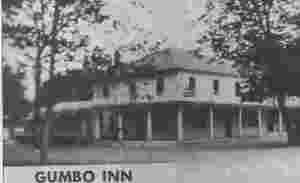Schneider, Harry Family
By Ann Chrissos
Chesterfield was an idyllic, pastoral community in the 1920s when Harry Schneider purchased the Twenty Five Mile House in Gumbo (Chesterfield Valley), Missouri. This general store and roadhouse-saloon had been established by Henry Wetzel in 1886 on the southeast corner of Olive Street Road (Chesterfield Airport Road) and Long Road. In 1906, it was given the name Twenty Five Mile House because it was twenty-five miles from downtown St. Louis. The building was then expanded to include a hotel. When Harry Schneider purchased the business in 1923, he changed the name to the Gumbo Inn. At this time, Prohibition had been in effect for three years. The Eighteenth Amendment to the United States Constitution, ratified in 1920 and repealed in 1933, prohibited the manufacture and sale of alcoholic beverages. However, when Schneider learned that his neighbor George Ruppel had a still on Johnson Island and was willing to sell the finished product, he decided to serve the illegal brew in his restaurant. Johnson Island is located in the Missouri River east of the Daniel Boone Bridge and north of the Chesterfield Athletic Complex. Ruppel transported the beverage in a false-bottomed truck to the Gumbo Inn, which made the Inn a popular destination for Sunday excursions by the Metro St. Louis gangsters, the Sheltons and the Eggns * and their girlfriends. The Shelton Gang, founded by Carl, Bernie and Earl Shelton, ran a major bootlegging operation from East St. Louis to Cairo, Illinois. Bootlegging meant the making, transporting and selling of illegal alcoholic beverages during Prohibition.
Harry Schneider was born in St. Louis, Missouri on August 8, 1881 and was educated in the City’s public school system. After he graduated from the eighth grade, he joined his father, George A. Schneider, in his bakery until the age of 23. He then worked as a representative and later as an inspector for the Prudential Life Insurance Company in East St. Louis, Illinois until 1914. For the next six years he owned and operated Allen’s Park, an amusement resort near East St. Louis. He sold out in 1920 and purchased Bellairs’ Grove, a restaurant known for its delicious chicken dinners. This experience served him well, when he became the proprietor of the Gumbo Inn in 1923. The roadhouse thrived on automobile parties and local clientele who liked the food, service and prices. The building was damaged in the 1993 flood and was raze in 1998. A McDonald’s Restaurant now occupies the site.
Schneider married Aurelia A. Bonneville on November 11, 1904. She was also a native of St. Louis who was born on June 25, 1883, the daughter of Charles Bonneville, a veteran railroad engineer. Harry and Aurelia had two sons: Charles A., born May 31, 1906 and Harry G. (Hap), born September 5, 1913. They also had one daughter, Bernice, born July 22, 1909. Bernice married Francis B. (Frank) Gerst in 1930 and they had six children: Jean, Robert, Carol, Ann, James and Joann. Aurelia died on March 4 1955 and Harry died on January 15, 1964. They are buried in the Old Saints Peter & Paul Catholic Cemetery at 7030 Gravois Avenue in St. Louis.
*Eggns probably refers to the Egan’s Rats. They were a St. Louis crime gang which operated in St. Louis, Missouri from 1890-1924. They were founded by Thomas “Snake” Kinney and Thomas Egan. Their criminal activity included bootlegging, voter intimidation, armed robbery and murder.
 |
 |
|
According to an advertisement in 1937, Gumbo Inn was located three miles east of the Daniel Boone Bridge on New Hwy. 61. Courtesy of CHLPC. |
St. Charles & St. Peters, Missouri, 2016. The lower circle shows the location of the Gumbo Inn and the upper circle shows Johnson Island home of George Ruppel’s still. |
Sources
Ancestery.com, Vital Records.
Chesterfield Historic and Landmarks Preservation Committee archives.
Gerst, Robert, grandson of Harry Schneider, was interviewed by Dan Rothwell and Arland Stemme on 21 Sept 1999.
Lhotka, Bill. St. Louis Crime Chronicles, 2009.
https://en.wikipedia.org, “Egan’s Rats.”
Morris, William, editor. American Heritage Dictionary, 1970.
